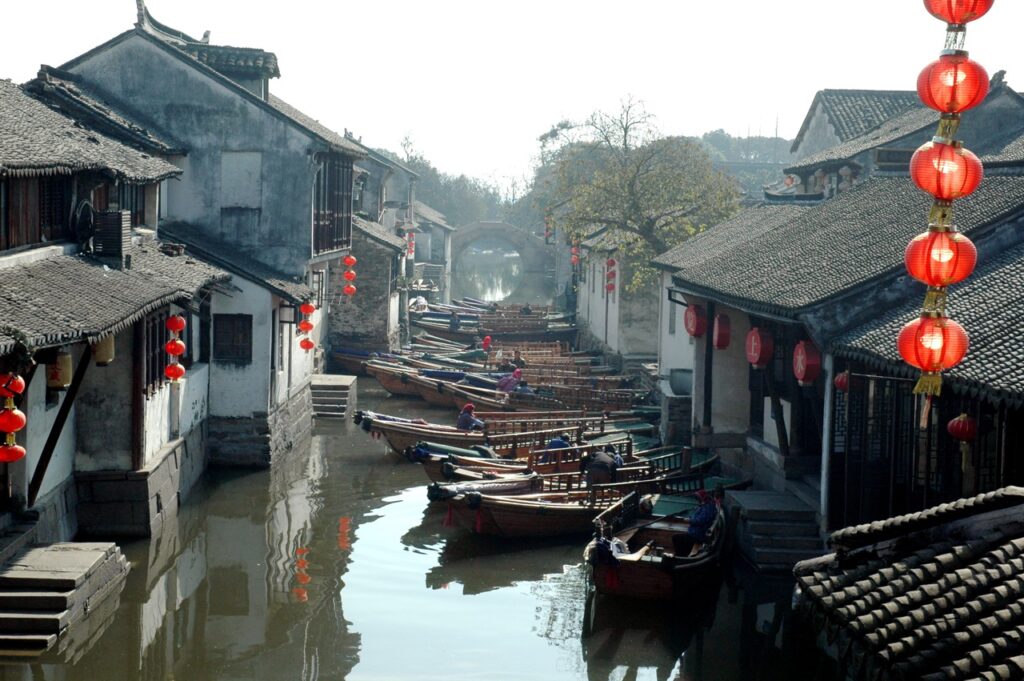In Suzhou, the Iron Bell Gate (16th century) has a tower that offers an unforgettable view of the sailboats sailing towards Beijing or Hangzhu. It was a vanguard post equipped with cannons because Japanese pirates were feared at the time. Today, another major risk exists: the influx of Chinese and foreign tourists! They come to seek their share of dreams in these water stories told by the Grand Canal. The latter shells, along the banks, many interesting localities. Criss-crossed with narrow streets, they are criss-crossed with canals whose half-moon bridges are photographed, each prettier than the next.
A titanic achievement
It is the oldest canal in the world and it has offered China exceptional mobility: nearly 2000 km of artificial waterways link five river basins (including the Yellow River and the Yangtze) with a view to traveling six counties. Its network of canals stretches from north to south and connects from east to west. With an ideal design in every respect, the Grand Canal was inscribed on the UNESCO World Heritage List in 2014.
Its construction began around the 5th century BC and it continued section by section, until the end of the 13th. Rebuilt under the Ming dynasty at the beginning of the 15th century, the Grand Canal irrigated many rice fields, transported hundreds of thousands of tons of goods including a quantity of cereals to the capital, building materials for the imperial palaces, armed troops in periods of conflict.. and, from time to time, a great traveler (Marco Polo) or the emperor of the moment descending to visit his other provinces! Trade enriched the merchants and the State which levied taxes, the movements favored cultural exchanges not only among the Chinese populations, but also in the world: a wreck and its load of 5000 pieces of ceramics were found in Indonesian waters. made in Changsha.
From collective work to automation
A hydraulic system can be maintained but, given the vagaries of history, it was not so for so long that in 1949 the communist state mobilized peasant forces to make the canal operational again. Collective works: re-digging and dredging of the canals, reactivation of the valves, locks, pumping systems, consolidation of the banks, raising of the land… Huge expenditure of human energy. Later, in the 1990s, electrification and automation domesticated this unique example of Chinese civil engineering.
Suzhou and its gardens
Return to the old center of Suzhou, its preserved alleys, its tea houses, its colorful markets and the most prestigious of its 16th century gardens: the Garden of Simple Politics. Lingering near its pavilion built on stilts and its lake dotted with islets is a delight. In the outbuildings of the garden, the Suhzou museum was renovated by M Pei, the architect of the Louvre pyramid. In this architectural wonder inspired by traditional housing, admire the famous miniature Pagoda adorned with thousands of gold and jade beads. See also the sumptuous embroidered costumes of the Opera Museum and the stelae dating from the Southern Song (12th and 13th centuries) kept in the Confucius Temple
Two traditional villages
They offer us a bit of this bygone China that makes us dream. No concrete. Nothing but alleys and canals lit by elegant red lanterns as soon as night falls. Old, modest or sumptuous houses and skittle boats to weave through unknown labyrinths.
Zhouzhuang. At the edge of Dianshang Lake, a hundred dwellings dating from the Ming and Quin dynasties were saved thanks to a painting representing the Double Bridge offered in 1985 to Deng Xiaoping. Double bridge spanning two canals of this sad abandoned village… A painter Chen Yifei, from the region, wanted to immortalize it. The statesman fell in love and a rescue plan was launched. Which propelled, a few years later, the village to the Double bridge in the tourist agencies. The bridge is still there and two houses are much visited: Zhang’s house (170 rooms, 6 interior courtyards, mooring platform for boats); Shen’s house (18th c. 2000 m2, 7 patios, period furniture and four-poster beds…the sale of opium was profitable!). At the exit of the village, you can treat yourself to a glimpse of the oldest form of Chinese opera, the kungu, revered for 600 years.
Tongli. With its whitewashed walls and tiled roofs, the village promises longevity, prosperity and health to those who successively cross the 3 bridges located in the heart of the village. The natives lend themselves to this ritual during a wedding, a birth or any other event… so why not try it before


